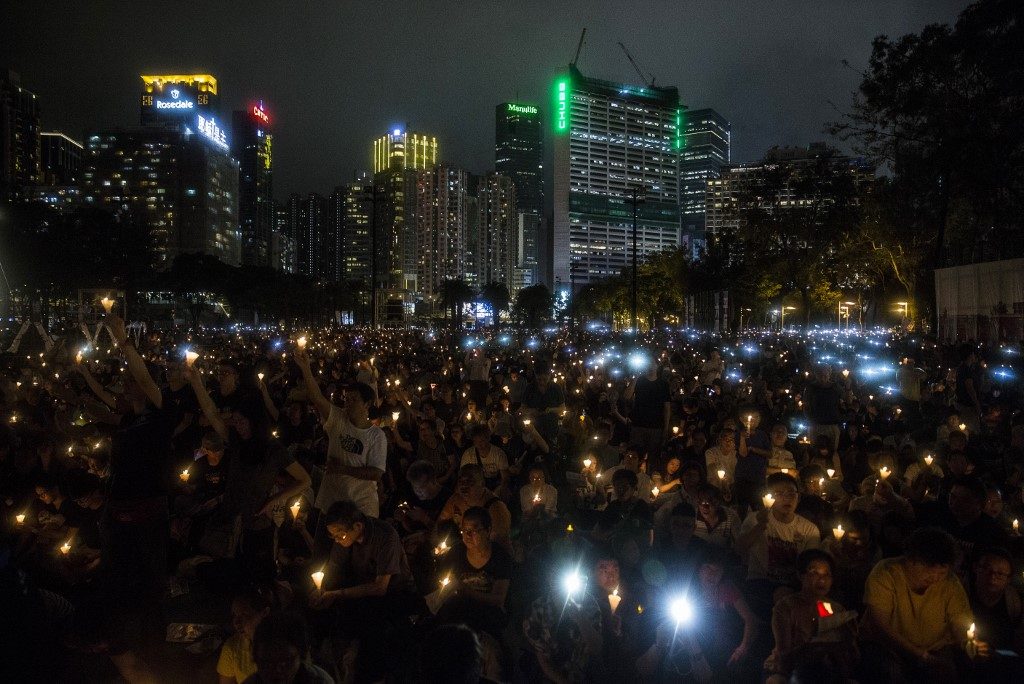SUMMARY
This is AI generated summarization, which may have errors. For context, always refer to the full article.

Over the past week, thousands of Chinese in numerous cities have protested against China’s COVID-19 lockdown policies, in one of the biggest acts of public defiance seen since President Xi Jinping came to power in 2012.
The following is a timeline of some other notable protests, and public dissent against China’s ruling Communist Party.
1978
Democracy Wall movement – In the late 1970s, after China’s tumultuous Cultural Revolution, individuals pasted “big character” posters on a brick wall on Xidan street in Beijing, in what became known as the Democracy Wall. Thousands marched in late November calling for greater democracy.
1989
Beijing’s Tiananmen Square – Crowds of up to 100,000 gathered over several months, led by students demanding Western-style freedoms and democratic reforms. Protests spread to Xian, Changsha, Chengdu and Shanghai. On June 4, troops fired on unarmed civilians, with rights groups saying hundreds, perhaps thousands were killed. A lone protester dubbed “tank man” blocks a line of tanks along Changan Avenue.
1999
Over 10,0000 members of the Falun Gong spiritual group gather outside ‘Zhongnanhai’ – China’s top leadership compound in a silent protest. Authorities later dub the group a “cult” and arrest thousands.
2008
Tibet – Hundreds of monks march in Tibet’s capital, Lhasa, triggering protests and clashes. Tibetan crowds burn shops, with a reported 18 deaths. Protests spread to over 130 locations in western China. Security is ramped up and access restricted. Tibet’s exiled spiritual leader, the Dalai Lama, later said the region had become “a hell on earth”.
2009
Xinjiang – In the region’s worst ethnic unrest in decades, ethnic Uighurs attacked majority Han Chinese in the capital Urumqi, after an incident involving Uighur workers in a factory in southern China. The bloody clashes, fuelled by what some Uighur leaders called “years of repression” by Beijing, claimed 197 lives, according to official figures. China later builds massive “facilities” to turn Xinjiang into what a United Nations panel described as a “massive internment camp shrouded in secrecy”.
2011
“Jasmine” protests – Following pro-democracy movements in the Middle East including the “Jasmine revolution” in Tunisia, Chinese netizens issue calls for small-scale public demonstrations in a number of cities including Beijing, Shanghai, and Guangzhou, to demand political reforms. Many are nipped in the bud, but several go ahead including one in Beijing where several journalists are roughed up by police.
2011
Parts of Inner Mongolia are rocked by protests by ethnic Mongols following the hit-and-run death of a herder protesting against pollution caused by a coal mine. In 2020, ethnic Mongols stage rare protests over changes to school curriculums that remove the Mongolian language from core subjects.
2011
Wukan – Protests break out in the southern Chinese fishing village of Wukan over land grabs by corrupt officials. The revolt draws an international media spotlight and ends with rare democratic concessions from authorities, including a village election. In later years, many rebel leaders are arrested and jailed. Fresh protests break out in 2016 but are quelled with further arrests.
January 2013
Southern Weekly protests – Small-scale public demonstrations demanding greater media freedoms are staged over several days outside one of China’s most liberal newspapers. The Guangzhou-based Southern Weekly is later brought under tighter government control and censorship, and many liberal-minded journalists forced out, or quit.
July 2015
Responding in part to the founding of the ‘New Citizens’ Movement’ – formed loosely of rights groups and individuals striving to end authoritarian rule in China – authorities launched a nationwide crackdown on July 9. The so-called “709” crackdown resulted in the arrests of over 300 human rights lawyers and activists, including Li Heping, Xu Zhiyong, Ding Jiaxi. Some are kept incommunicado under “residential” detention for months on end and tortured.
2019
Millions in Hong Kong stage anti-China and pro-democracy protests over many months in the boldest, most protracted populist challenge to Beijing’s leaders since 1989. China later imposes a powerful national security law, arresting scores of democrats and shutting down civil society groups and liberal media outlets, including the Apple Daily newspaper.
2022
Henan bank protests – Public protests simmer as thousands lose access to their savings in a banking fraud scandal centered on rural lenders in Henan and Anhui provinces.
October 2022
A lone man drapes white banners from an overpass at Beijing’s Sitong bridge before a landmark party congress when Xi secured a third term as China’s leader. Some of the slogans
include: “We don’t want a supreme leader, we want a vote” and “Don’t be a slave, be a citizen”. Dubbed “bridge man” or “the new tank man”, the protester has inspired some protesters now calling for broader freedoms and an end to COVID lockdown measures. – Rappler.com
Add a comment
How does this make you feel?
There are no comments yet. Add your comment to start the conversation.